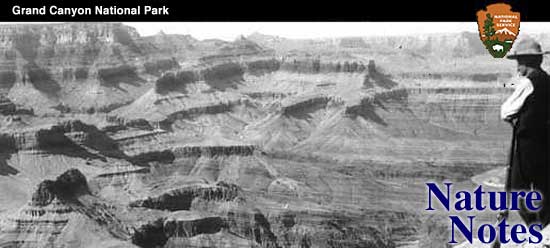

|
By Acting Park Naturalist Donald E. McHenry IN these days when the Grand Canyon National Park is a hive of activity at the hands of the Civilian Conservation Corps, National Industrial Recovery Act Workers and Civil Works Administration Workers, it is worthwhile noting that some of this industry has found its way into the Educational and Research Division. Four of the C.C.C. boys were assigned to museum detail. Their first job was to assist Ranger Naturalist Louis Schellbach in the reorganization of the archaeological exhibits at Wayside Museum of Archaeology. Part of the work consisted of assembling and restoring a number of ancient Indian pottery specimens. The remarkable skill they displayed in doing this work can be appreciated somewhat by an examination of the accompanying photograph showing the boys actually at work in the office of the Park Naturalist. Most of the pots shown were in a number of broken bits before the work commenced. In some cases plaster of paris substituted for the missing pieces as can be seen in the hands of the boy on the right. They rebuilt completely seven pots and cleaned some miscellaneous fragments. In addition the boys cleaned and catalogued about 2,500 pot sherds from about 100 surface collections at Indian Pueblo ruin sites in Grand Canyon; three Indian baskets of the Colonial Period; a pair of Indian weaving sticks; about 30 bones of various descriptions and uses; a dozen basket fragments; two pairs of fiber sandles and 250 arrowhead specimens. A large cross-section of Western Yellow Pine, exhibited at Wayside Museum, showing dated tree rings was polished in order to bring out the rings more distinctly. Some archaeological materials from the Wayside Museum were re-catalogued. After the archaeological work, these C.C.C. boys gathered together about 350 plant specimens which had been collected in the Canyon in the past few years. These plants had been stored away because of lack of time and means for properly arranging them. This will make a valuable additional display aid visitors to understand the floral structure of the Canyon. Much of the value of this scientific material lies in the information about it. This information has been carefully classified and catalogued by the boys. Certainly one very necessary qualification for these workers is versatility and the boys on the museum detail are well supplied with it.
Many of our readers will find it difficult to realize the amount of careful, painstaking work all this has involved. Add to this the fact that none of these boys had had any previous experience in this kind of work. But a very valuable asset has been their decided interest in this project and their willingness and ability to learn. Such work as these C.C.C. boys are doing can be classed as the highest type of conservation work. They are to be congratulated upon such a splendid spirit of cooperation which alone makes possible the execution of this valuable work. | ||||||
| <<< Previous | > Cover < | Next >>> |
vol8-10e.htm
14-Oct-2011